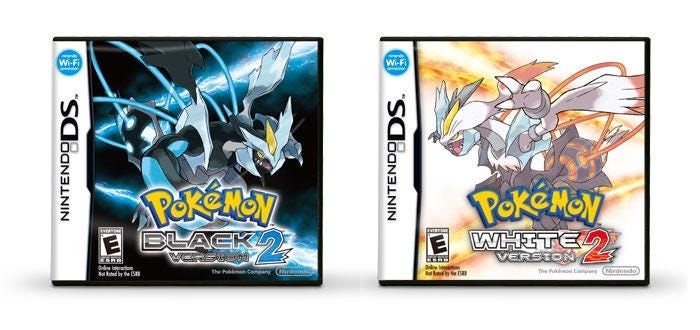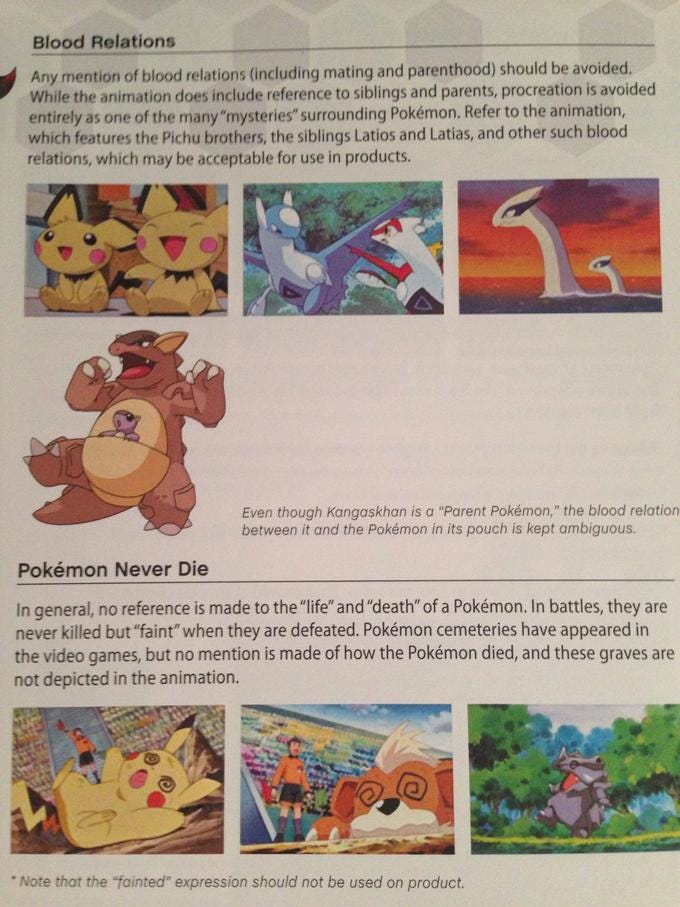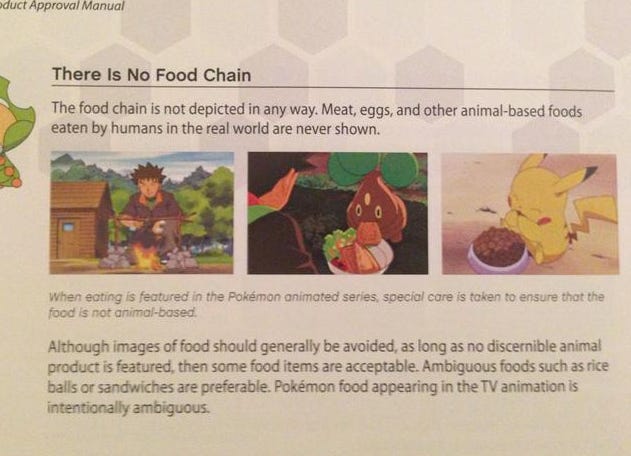Sacrifices to the Altar of The Pokémon Company International
I Am Takeshi Shudo's Strongest Soldier
Pokémon was a pretty novel concept for its day. It was basically the first handheld RPG that actually took advantage of the fact that it was on a handheld and not vainly attempting to cram a console game onto that miniscule screen — its design revolves around the Game Boy and its unique capabilities. It was created, as most good things are, by a bunch of crazy people working long hours for little pay over many years. Visionary artists, composers, programmers and designers collaborated on this and they accidentally created a global cultural phenomenon in some rented office space.
Who could’ve possibly predicted that this would happen? How do you handle such newfound success?
The answer is: You can’t. You can’t handle suddenly becoming the sole load-bearing pillar upon which a multi-billion dollar media empire rests its entire weight on. It’s not a tenable situation, artists want to make art, not crunch numbers and sit in meetings. To that end, The Pokémon Company was formed as a joint venture between Game Freak, Creatures Inc., and Nintendo as a means of handling the portfolio, and it would be this that sealed the franchise’s fate.
I’ll return to this in a moment, but first I want to talk about a very curious individual. His name was Takeshi Shudo, and he killed Minky Momo. He also wrote the first two films in the Legend of the Galactic Heroes series, Legend of the Galactic Heroes: My Conquest is the Sea of Stars and its sequel Overture to a New War.
Also, Goshogun. I like Goshogun.
Rest in Peace, King. You deserve a break.
Takeshi Shudo was the lead writer for the Pokémon anime, and after having not worked on the series for some time, passed away after suffering a subarachnoid haemorrhage in 2010. He was, rather infamously, a drinker and an addict to various narcotics, but he wasn’t always that way. His pain was slow burning, and we can trace it all back to his time on the Pokémon anime, specifically the second film. Thus begins the most well-known sacrifice to the altar of The Pokémon Company; Lugia.
Funnily enough, this had no bearing on Shadow Lugia’s designation as Pokémon XD-001 in Gale of Darkness.
Shudo is credited as one of the co-creators of the Pokémon Lugia, alongside franchise art director Ken Sugimori. Originally envisioned as a “Mother of the Sea” entity and a water-type, Lugia had a very particular role in the narrative of the second film. In its original form it was known as “Pokémon X” via marketing materials, hence the X-pattern on its belly shown in this early concept art. The second film wasn’t even really about Satoshi and friends, it was almost entirely divorced from them until massive rewrites demanded that the plot and status of Lugia be altered and many staff members pointed out that the film lacked all of the main characters from the anime.
As you’ve surely guessed by now, Lugia ended up becoming the mascot of Pokémon Silver, alongside Ho-Oh, but the two were never designed as counterparts. Originally, Ho-Oh was simply the mascot of both games, appearing on the title screens of both Gold and Silver versions during development.
When Shudo learned that Lugia was to be stripped of context and turned into merely another piece of merchandise, it was arguably the beginning of what can only be described as an immense, decade-long depressive spiral. The Pokémon anime had already been wrested from him in terms of creative control, and many plotlines he wanted to make good on simply never came to pass. A lot of his lamentations and misgivings were documented on his blog over the years, describing his writing process during the period which was fueled by alcohol and horse tranquilizers. By the time the second film was finished, Gold and Silver were still unreleased (owing to major delays and basically restarting development entirely halfway through — a tale for another day.).
A reflection of a truer vision for a sequel. Earlier builds even called it “Pokémon 2: Gold Version and Silver Version”.
I went through the trouble of painting a tiny part of Shudo’s tale because it illustrates what happens when the multimedia machine gets its teeth into something good and rich with detail. Early Pokémon was a fertile breeding ground for great stories and characters — it was designed that way, really. The manga Pokémon Special reflected this, and its first major arc (“Red Chapter”) was seen as the truest portrayal of the world that was being depicted by Satoshi Tajiri at the time, and this material is praised for good reason. Over time, good elements of this media (“cells”) are spent to fuel the vigour of the “organism”, and it’s a nigh-unstoppable process. A cynical process of margins and number crunching and focus testing.
Eventually, all of this paranoid crunching drives away the people with talent who started the media empire in the first place (Bad things generally don’t catapult themselves into popularity, they often start out pretty good and then get worse).
The result is an abomination like this thing, Gholdengo, and your psychologically conditioned fanbase eats it up like a gourmet meal, because they’re emotionally invested and paid sixty bucks for a game that wasn’t even finished. This is the win-state of all franchises, and Pokémon’s been doing it for longer than most of its current player base has been alive for.
I would be very interested in a “fly on the wall” scenario documenting how this crime against art was birthed.
Now the cynics among you might proclaim that, well, Shudo created these scripts and characters under contract; The Pokémon Company is free to do with it as they see fit. Correct, in a legal sense, but anyone who isn’t a hapless bootlicker will also understand that the law and morality coincide so few times that they may as well be separate entities. The law exists to uphold the hegemony of entities like The Pokémon Company.
The right thing to do is another thing entirely, and I don’t believe I need to provide some objective proof that taking something someone made, stripping it of context and turning it into yet another object of merchandise for children instead of something that had a more wholesome thematic purpose is a dick move.
The right thing to do would be to supply your animation staff with enough budget to make ends meet, but if employee testimony is to be believed, the average animator for the Pokémon anime under OLM makes less than a part-time convenience store worker. In Japan, to quit in such an industry is to be blacklisted. It’s an awful double-bind, one that is easily corrected, but one that The Pokémon Company International refuses to correct outright, because they have no legal compulsion to do it, and executives only end up as executives because they have no moral integrity whatsoever.
Obviously, explaining that The Pokémon Company is a pervasively evil force that treats both its staff (who produce the media) and its customers (who purchase the media) like complete shit is something that most people will never intuitively understand. It’s a pretty stark divide.
I mean it in the nicest possible way, but at least 80% of humanity are completely hapless consumers who believe that these things are immaculately conceived and sent out. They have no conception of the machinations and the processes that go into it, like an infant who lacks object permanence. Joe Merrick is like this, and unfortunately he’s painted himself as the “community spokesman”, even though his technical knowledge of these games is about ankle-deep, while people who work with them on a source-code level near enough daily attempt to correct his boneheaded statements to no avail. I guess you have to make the twenty years of financial and time investment worth something.
You cannot convince these people of the evil, because they were born into the evil and have wallowed in it happily ever since. Disturbing them will make them ornery. Go ahead, tell them they’re paying more money for objectively less and watch them go crazy with pie-in-the-sky coping mechanisms for hours. Stare too long at the abyss and the abyss stares back, and suddenly the framework of Pokémon begins to look as old as it actually is, and you also begin to realise that if every good feature from each progressive title was actually iterated on and kept between games we would’ve had “The Perfect Pokémon Game” about fifteen or so years ago. These days, they can’t even get basic terrain loading right on their third Switch game.
These two games probably came closer than any other to the platonic ideal of “Pokémon”, but naturally all the lessons it taught to the world were forgotten because it only sold half a metric asston of copies rather than the whole metric asston they’re used to.
As a cultural entity that has permeated almost every medium on planet Earth, from novels to live action film to animation and even pogs, Pokémon offers a wealth of avenues by which for an individual to engage with aspects of the franchise, but ultimately it all comes off as fake and vague. There is a suggestion of a world, some abstract idea, but because brands require a huge amount of anxious meddling to stay completely clean in the modern day, they refuse to make any particular sweeping or long-lasting statements. Elements are introduced and dropped, ad-hoc, at the expense of the individuals who created these elements.
Read any “brand guideline” that leaks in the current day and be prepared for a mental assault of some of the most schizophrenic and unexplainable hard-rules that all media must abide by. Pokémon is no different.
So little do TPCi think of children that they think them unable to conceive of a highly fantastical Earth.
The original Pokémon games were pretty obvious about it — Pokémon took place on Earth. A highly abstracted and fantastical one, one that had adapted to the presence of superpowered creatures in the wilds. Its world design was considered around these aspects in all ways. It was built on classic science fiction tropes like mass-energy conversion and a sort of utopic reality with a dark underbelly revolving around the use of these creatures.
The Kanto region was not merely “a country”, it was Kanto, Japan. The first four Pokémon games feature regions based directly on real regions in Japan, and the prototype map for Gold and Silver show a map that spanned the entirety of the Japanese land-mass. There were Indian elephants, a Silph Co. employee laments being sent to the Tiksi Branch in Russian no-man’s land. Lt. Surge was The Lightning American. While this may seem inconsequential, it gave us a frame of reference for the world, a sense of space and geography — the essence of worldbuilding.
Pokémon have no explicit relatives and they don’t mention how they die, even though the games feature explicit genetic mechanisms and there’s mention of Team Rocket killing a Marowak in the original games and all remakes thereof.
This meddling goes as far to directly contradict the primary source material. According to them, kids are too stupid or would be too traumatized by being exposed to media that touches on the concept of reproduction, or of siblings, and so everything must be kept ambiguous lest they… understand mortality? What kind of insanity is this? This can only come from a company who genuinely thinks that its primary target demographic lacks a functioning frontal lobe. This coddling is a broader issue but when media itself begins to censor fundamental parts of mortal existence, it begins to illustrate a broader trend of wishing for a world with no “nasty bits”. It’s a perfect comfort, and never ever challenging.
Don’t let little Timmy hear that they kill cows for his burgers. He might cry.
Even denial of basic aspects of biology undermine Pokémon’s own worldbuilding. Pokémon occupy a permanent state of being designed around what they eat (Or at least, that’s what they tell us nowadays. I don’t believe it.) and also being able to eat only unidentifiable cartoon muck. Heatmor cannot hunt Durant but also, Heatmor and Durant are designed as a pair around this fact. Relegated to lore text most people never read. It’s cheap and I can’t think of anything else that does this.
Giovanni kills like two Magmar here. It’s a defining moment that establishes him as a real calculated threat.
It speaks to a certain kind of arrogance that these elements are the way they are. I first read Pokémon Special as a child, around 9 years old. I was blown away at how real the drama felt, of how these superpowered creatures really acted like the threats they had only ever been gestured at being before. It made the anime look like pre-schooler’s stuff, but I realise years on that Special wasn’t really aimed at a higher demographic than the anime was. It was just a fundamentally different attitude taken, one that has begrudgingly only been allowed to continue existing because it was so popular and began so early in the life of the franchise. Pokémon bled and died, trainers were at risk if they took a wrong step. These were wild animals. The drama was intense, and reflected a true vision of the utopic urban-fantasy that the original games were going for.
Unfortunately, not even this manga was safe from being sacrificed for the vigour of the machine. Pokémon Special’s whole thing was that it was a piecemeal adaptation of game stories in manga format, and so when games began coming out at a quicker and quicker rate, the writer and artist couldn’t wrap up plots in time, leading to either comically short parts of the series like XY Chapter or plots that took nearly eight years to wrap up in-between other parts (Black and White/Black 2 and White 2 Chapters). Their current schedule is back-to-back rammed, and discussion about the series has all but died in English-speaking circles. While my personal opinion of it dropped at about Gold and Silver Chapter, it’s a shame that it ended up this way. Even art I don’t like deserves room to breathe.
Berserk fans ain’t shit. Black was stuck in the Light Stone for 8 years.
I’ve spoken at length at sacrifices to the machine, but how do we solve this problem? The answer is, you can’t really solve it. You just have to work around it until it finally gets a tumour and dies or something. No single force is large enough to put it out of its misery and joining the machine to try and change it from the inside is a moot point due to the power structure involved.
I see a lot of indie monster-collector games that really just feel like repackaged Pokémon. They present no new ideas, break no new artistic ground, and I won’t name them but if anyone making them is reading this you probably already know who you are. It’s just a bad copy, “We Have Pokémon At Home” type deal. You have to be transgressive. You have to be bold, and go in new directions. You have to shock, you have to be personal, you have to do everything that the successful guys aren’t doing. Get your teeth into the 20% of people who aren’t hopelessly braindead drones and start appealing to them. They’re your future, baby.
Hell, if you’re lucky you might end up having your counter-culture become the culture, like The Simpsons. Then you can simply pretend your problems don’t exist, because most problems can be solved with money.














Massive props for this write-up. As someone who got into games, anime, and manga, all because of Pokémon, this is a gut-wrenching read, but it's in many ways a deeply valuable one in conceptualizing feelings.
One thing I'd add is how the franchise handled Legendries. Because there was a pretty consistent trajectory in terms of how we progressed with them - Mew was the genetic predecessor of all Pokemon, Ho-Oh and Celebi were clearly intended as Kami, then we moved up to the primordial entities embodying the earth, and finally the literal God who created the universe and its offshoots. There was a real sense of scope provided in this premise that felt captivating, and while there are issues with them there as well, it felt really cool and interesting.
Now, though, Legendries exist like theme park attractions. Just a promotional gimmick to be used for marketing, divorced from any real artistic ideology. Zacian and Zamazeta aren't special or unique, they're just another gimmick for this latest iteration of the same cycle. Koraidon and Miraidon aren't even special in-universe, they're just devolved/evolved versions of a generic mon. It's purely soulless and artificial.
At this point, I think it's up to the fandom to save Pokemon from itself. I would be very, very interested in someone creating a fangame based on Shudo's original conception for the 3rd Pokemon movie. You know, questions about what happened to real-world animals, and the real, actual T-rex fossil coming to life. I remember a write-up for it existing on Dogasu's site. However, something like that would take a person who's actually read Shudo's works and understands his concepts well enough to adapt them. An undertaking like that is really the only way one could see Pokemon return to its roots. There is no hope for TPCi / Nintendo to do anything other than milk this cash cow for all it's worth, and continue to dilute and strip Pokemon of its soul.